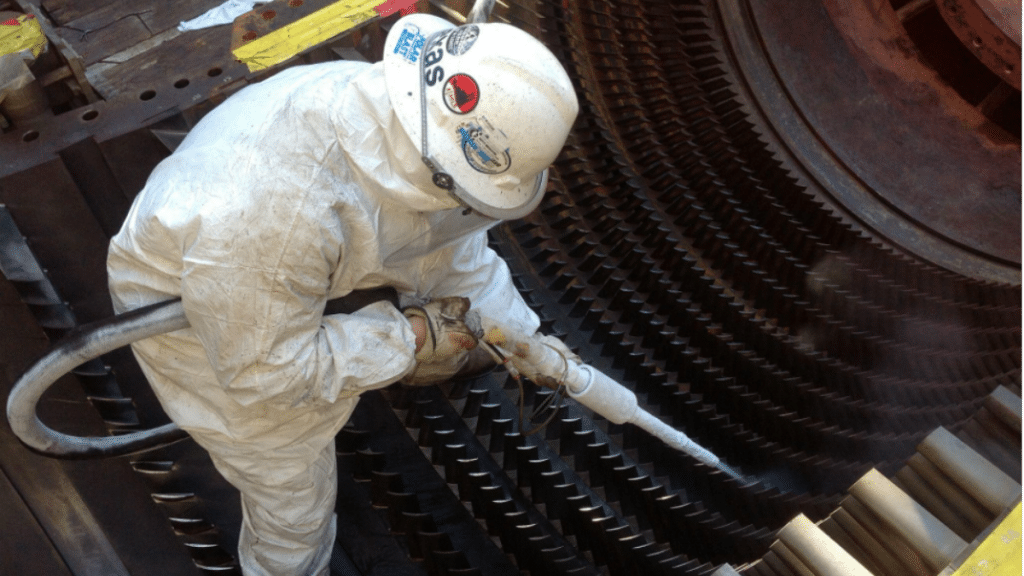Keeping power generation equipment clean and running efficiently is a constant challenge for power plant professionals. Downtime can spell big trouble — both in lost productivity and energy supply.
While there are multiple methods for cleaning and maintaining power generation facilities and equipment, many are problematic with their introduction of water, chemicals or residual debris.
Here’s an overview of commonly used blasting solutions used to clean power generation facilities.
The Power of Dry Ice Blasting
Dry ice blasting is a standout cleaning method for power plants because it’s non-abrasive, water-free, and leaves no mess behind. Dry ice blasting uses CO2 pellets, blasted at high speeds, to break up dirt, grime, and other stubborn buildups — all without water, chemicals, or residue. Plus, dry ice sublimates (turns from solid to gas) on contact, leaving nothing behind but the cleaned surface.
What makes dry ice blasting so effective?
- Non-abrasive yet thorough: it’s gentle enough for delicate parts like control panels and generators but tough on contaminants
- No secondary waste: since the dry ice evaporates, the only cleanup required is removing the dislodged contaminants
- Minimal downtime: equipment can often be cleaned in place without disassembly, saving time and money
- Environmentally friendly: dry ice is sourced from industrial byproducts, and the process doesn’t use harmful chemicals
- Non–conductive: safe to use around electrical equipment
While dry ice blasting is exceptionally versatile, it’s not a one-size-fits-all solution. Some situations call for more abrasive power and different techniques to get the job done.
Other Blasting Methods Pros & Cons
Here’s a quick look at some of the most common cleaning methods used in power generation facilities and how they stack up against dry ice blasting.
Abrasive Blasting
Think of sandblasting, but with different grit sizes and materials. It’s great for prepping surfaces for painting or removing heavy buildups. However, it can create a lot of dust, waste, and potential respiratory hazards.
Sponge Blasting
Sponge blasting uses reusable synthetic sponge pieces embedded with abrasive particles. It’s ability to suppress dust makes its an effective option for tight spaces and steam turbines, but it can be slower and more expensive.
Steam Cleaning
If you’re dealing with grease or oil, steam cleaning might be the answer. It’s chemical-free but can introduce moisture, which isn’t ideal for electrical components.
Hydroblasting
Using high-pressure water jets, hydroblasting is versatile but not ideal for electrical equipment or moisture-sensitive areas. Plus, it requires drying time and produces secondary waste.
Hand Cleaning
Simple and precise, hand cleaning requires minimal equipment but is labor-intensive, costly, and ineffective against tougher deposits.
Chemical Cleaning
Effective for specific tasks with low material costs, chemical cleaning is often frowned upon due to potential environmental risks, health hazards, and the potential for damage if not used properly.
When & Where to Use Blasting in Power Generation
Each method has its place in power generation, whether you’re dealing with turbines, generators, or electrical equipment.
- Turbine Cleaning
Natural gas turbines benefit greatly from dry ice blasting, reducing cleaning times significantly. Steam turbines often require more abrasive methods to tackle mineral deposits, rust, and scale. Techniques like aluminum oxide or sponge blasting are an effective alternative.
- SCR Systems & HRSG Cleaning
Selective Catalytic Reduction (SCR) systems, which filter out nitrogen oxide emissions, and Heat Recovery Steam Generators (HRSGs) accumulate debris and toxins over time. Dry ice blasting cleans these components, preventing backpressure issues and ensuring peak efficiency.
- Electrical Components
Control panels, insulators, circuit boards, and other electrical equipment can gather dust and grime. Dry ice blasting is gentle enough for even the most delicate electrical surfaces, making it a preferred choice over manual cleaning.
Safety & Logistics of Blasting Solutions for Power Generation
Cleaning isn’t always straightforward, and safety is key. Some power generation cleaning jobs require special planning, like:
- Containment: to prevent debris from contaminating the area
- Height/Scaffolding: accessing high or hard-to-reach areas safely
- Confined Spaces: PPE and certifications are necessary for tight or hazardous environments
- Hazardous Substances: dealing with lead or asbestos requires specialized training
The Takeaway
From the type of debris and surface to safety considerations, choosing the right cleaning method for power generation equipment depends on your facility and its demands, constraints, and more.
While dry ice blasting is often a top contender for its efficiency, environmental benefits, and gentle cleaning capabilities, at times, other methods like abrasive or sponge blasting may be more appropriate for more stubborn buildups.
